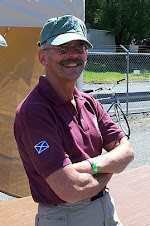This photo shows the hunk of Clarno Walnut, one of the barrels, the lock, trigger, a
 nd brass triggerguard, butt plate and ramrod ferrules. The walnut was 2"x16''x33" and yielded blanks for the rifle and a pistol. I selected the best part of the wood with the most character for the rifle stock blank. To make the stock blank I printed a photo of a NE Rifle and using an overhead projector I traced the photo onto white butcher paper which I then transferred to Plexiglas to make the pattern. I then cut the Plexiglas pattern out using a band saw, traced out the stock using the Plexiglas pattern , and finally cut out the stock blank using the same band saw. A lot of work.
nd brass triggerguard, butt plate and ramrod ferrules. The walnut was 2"x16''x33" and yielded blanks for the rifle and a pistol. I selected the best part of the wood with the most character for the rifle stock blank. To make the stock blank I printed a photo of a NE Rifle and using an overhead projector I traced the photo onto white butcher paper which I then transferred to Plexiglas to make the pattern. I then cut the Plexiglas pattern out using a band saw, traced out the stock using the Plexiglas pattern , and finally cut out the stock blank using the same band saw. A lot of work.
This photo shows the lock after it has been inlet into the blank.
The barrel and breach plug are inlet first then the lock. The lock a L.R. Maslin from L&R Lock Co., considered a small Durrs Egg Lock.
The rifle as it has taken shape. It weighs about 6 pounds and has a nice feel to it with a 32" .54 caliber rifled barrel and 32" 28 guage smooth bore barrel. Since the rifle was at this stage I have inlet a star (not shown) into the cheek piece using Australian Cypress and ubber dense African Blackwood. The African Blackwood was used as the nose cap instead of horn.







 An image showing the finished sliding wooden patchbox with its brass plate inlet into the butt and brass butt plate.
An image showing the finished sliding wooden patchbox with its brass plate inlet into the butt and brass butt plate.







